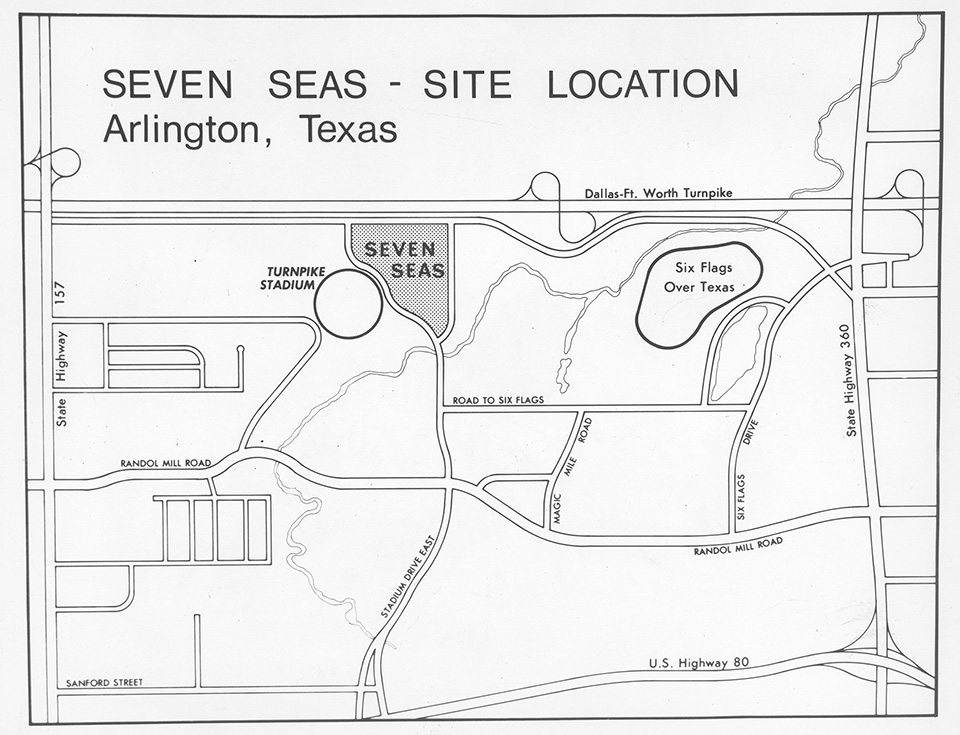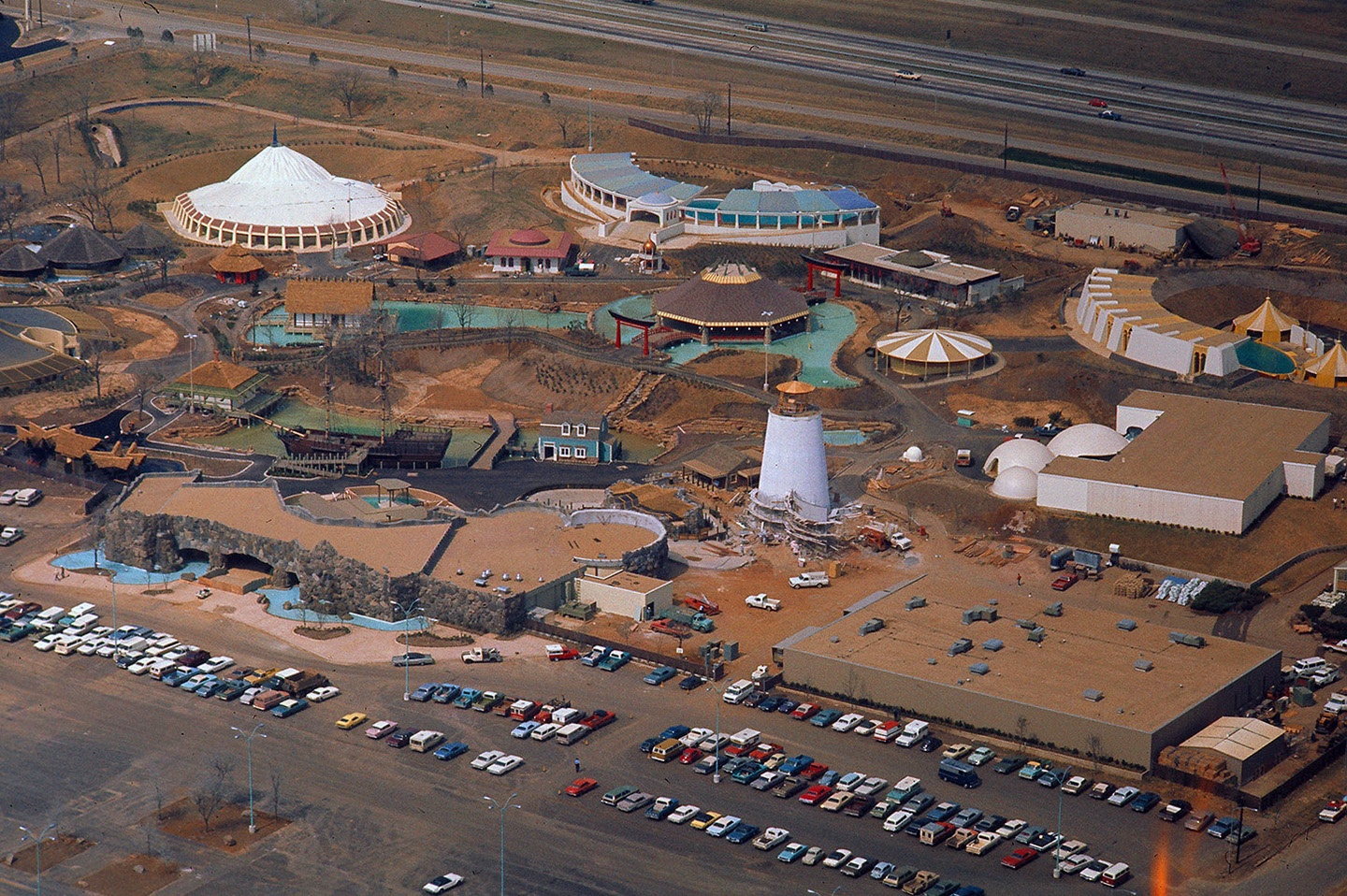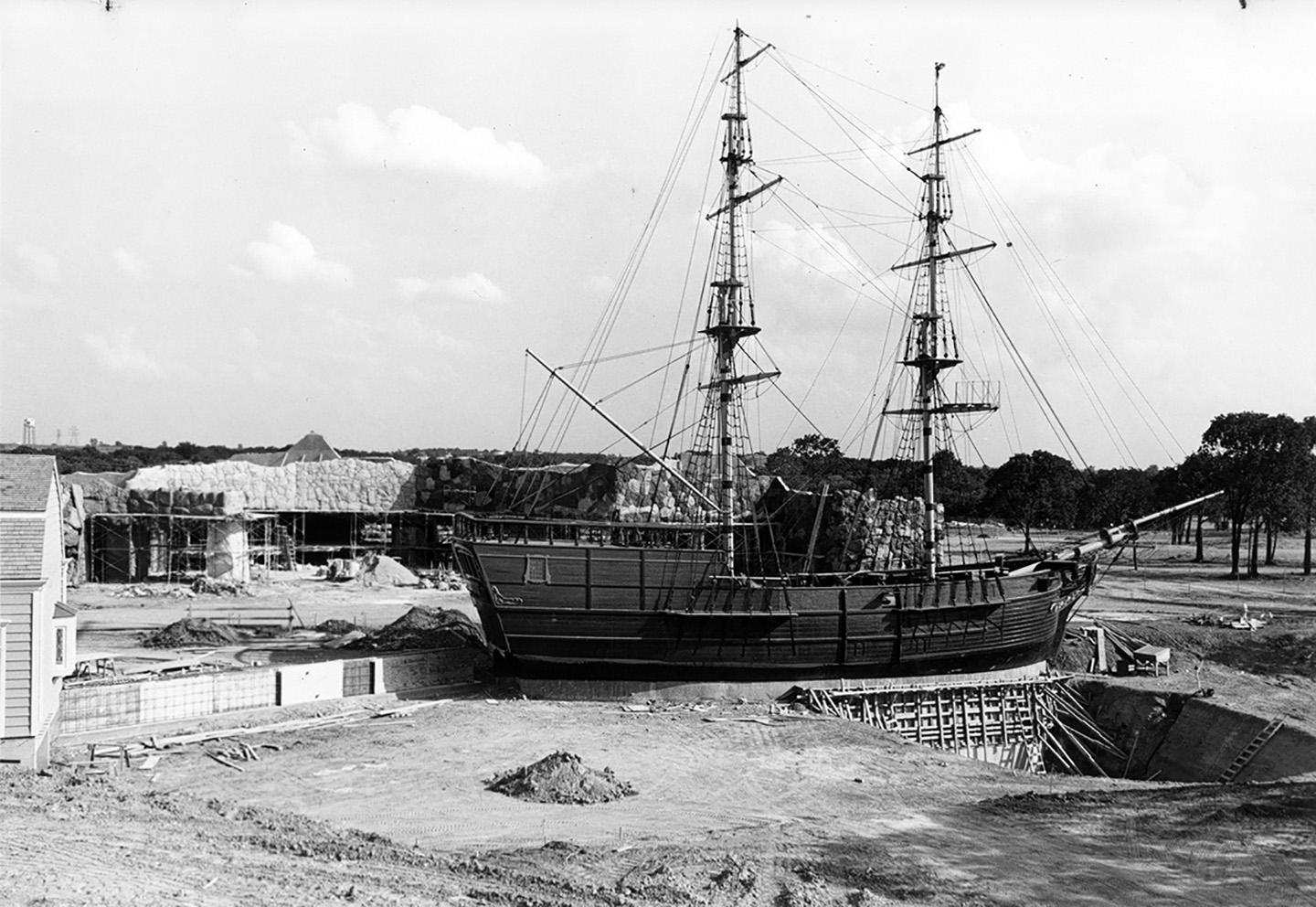
The Saga of Seven Seas - Part 2
Plans for Arlington's exciting new inland oceanarium were unveiled to the public in the spring of 1970. Mayor Tom Vandergriff was stoked, and again, his enthusiasm was proving infectious; big wheels were turning.
On April 18, the Fort Worth Star-Telegram carried the story: The city of Arlington would fund the construction of Seven Seas. A contract to lease and operate the park had been awarded to the Great Southwest Corp., guaranteeing the city either $700,000 annually or a percentage of the gate receipts, whichever amount was higher. A $10 million general obligation bond election would be called to cover construction and expansion costs. Mayor Vandergriff assured the media there would be no danger to taxpayers if the bond issue passed; the contract with Great Southwest would provide more than enough to cover the debt retirement schedule.
Mike Jenkins, vice president of new projects for Six Flags, Inc., said the park would be operated on a similar schedule as its neighboring Six Flags Over Texas. There would be seven areas, each representing one of the seas, where attractions and exhibits would be located. The park would have only one ride: an ice sled ride through the Arctic Ocean area.
The bond proposal was expected to be approved within the month. Construction was slated to begin on June 15, 1970. The park’s grand opening would be June 11, 1971.

“We want to open Seven Seas next summer and play football in Turnpike Stadium this fall,” announced a jubilant Mayor Vandergriff following 3 to 1 approval by voters of the $10 million bond issue. “We are thrilled both by the margin of approval and the total vote, which was by far the largest ever in an Arlington bond election. It is gratifying to realize this project caught the imagination of our people as it did. Frankly, it’s an inspiration to live in and work for Arlington.”
Vandergriff commented that the extent of the stadium expansion would depend on specific costs for construction of the 133-acre sea life park. Even though the two projects went hand-in-hand, Seven Seas had assumed a place of paramount importance on Tommy Vandergriff's agenda.
Seven Seas was declared “another jewel in the entertainment crown of this community” by Senior Arlington Councilman and future mayor S. J. Stovall in a brief groundbreaking ceremony on July 8, 1970, just before the first dirt was shoveled.
More specifics were brought to light; the park would include 20 buildings in its seven sections, with each section having a major attraction and tanks containing sea animals of the area represented. The park’s main lagoon would feature a sailing ship housing educational exhibits. High-diving exhibitions would be given from the ship’s masts.
Marine fossils were discovered during excavations for the killer whales’ tank. “It just confirms what we’ve known for 20 years,” said Dr. Charles Dodge of the University of Texas at Arlington, namely, that North Texas was once under water. “Roughly 100 million years ago,” he said, “this area was similar to the Mississippi Delta as it is today. Actually, this area has been under water many, many times.” Angus Wynne added, “I think it adds a special note of significance to this project. It’s like a 100-million-year-old metamorphosis.” Interestingly, this minor discovery would precede a much more important paleontological discovery in Arlington some thirty years later and just a few miles away: the Arlington Archosaur Site.
By the early fall of 1970, investors had started jumping on the bandwagon, buying up nearby tracts of land for development around Arlington’s growing entertainment district. These projects included a $25 million planned development for a 50-acre site at the intersection of State Highway 157 (Collins Street) and Randol Mill Road, adjacent to Seven Seas and Six Flags. The development would include motels, a shopping center, office buildings, and apartments. The flames sparked by Vandergriff’s ideas were spreading into other movers’ and shakers' minds—and pocketbooks.
Meanwhile, work was expedited on the killer whale facility at Seven Seas as the two whales purchased for the park were now scheduled to arrive in Arlington in December or January. The facility included a holding tank and a complex salt-water filtration system.
By Thanksgiving of 1970, 100 construction workers were working daily toward a summer 1971 opening for Seven Seas, with all projects “pretty much on schedule.” Various pools and filtering plants were sprouting throughout the park, and workers could be seen unloading shipments of “feather rock,” light porous stone that would be used to simulate caves leading into the park’s main entrance and restaurant.

The first sign of trouble for Seven Seas was brough to light in the Fort Worth Star-Telegram's December 17, 1970 edition. With work on the park in progress for four months, an article headlined “Oceanarium Work May Be Curbed” disclosed that Great Southwest Corp. was having difficulty obtaining a performance bond required by state law. Bonding companies were reluctant to insure GSC’s role as a general contractor for the $6.3 million construction phase.
For Tom Vandergriff and the City of Arlington, the road to Seven Seas had been a smooth one up to this point. The ride was about to get bumpy.
Penn Central Railroad, the parent company of Great Southwest, was facing near-fatal financial setbacks. Six Flags was ordered to pull out of the Seven Seas project immediately. Its contract with the City of Arlington was canceled through a recision agreement by both parties. Banks attempting to salvage Penn Central installed new management in its various companies and Angus Wynne was among those axed.
Mayor Vandergriff and the City of Arlington could foresee no better prospect than to take the reins for the completion of Seven Seas and its future profitability.
Progress on the park’s buildings and infrastructure continued. The sailing ship Bona Venture was under construction in San Diego, California, and scheduled to arrive in Arlington by February. A $75 million building permit for work on the park boosted January building permit totals to a record high for the city.
A second major blow was dealt to the project in February when members of Fort Worth Local 116, International Brotherhood of Electrical Workers, left the job because non-union TESCO employees were installing a high-voltage distribution line through the park—a job the Local 116 said should be performed by union labor. This was the first in a series of union strikes and disputes that would continue pushing the park’s opening date out. Meanwhile, the menagerie of sea animals that had been purchased thus far would start arriving at the park; their habitats had to be ready, along with the sophisticated water filtration systems required to keep them alive and healthy. A major logistical and financial nightmare was taking shape, and Tom Vandergriff shouldered most of the political burden of keeping enthusiasm for Seven Seas firing on all cylinders.
At the end of its March 16, 1971, city council meeting, the City of Arlington announced it would take full ownership of Seven Seas. The city would receive all revenue from the park rather than the $700,000 called for under the previous contract with Six Flags, Inc., a GSC subsidiary. Mayor Tom Vandergriff said he expected “tremendously more than $700,000” in annual revenue, calling the move “the greatest single guarantee of financial stability.” He went on to say that city operation of Seven Seas “has always been my personal hope and preference.” The phrase “be careful what you wish for” had never been more applicable.
The park’s planned opening date was pushed back to July… then August. Despite the change in management, the oceanarium was still expected to open in late summer.
On March 5, Donald S. Praeger, Jr., Vandergriff’s only opponent for mayor in the upcoming April 6 city election, contacted area news outlets to report he was filing suit to seek an injunction that would halt construction at Seven Seas. The 27-year-old candidate claimed that the city began negotiations with subcontractors who had submitted bids to Great Southwest for various stages of construction, but did so with substantial amounts of public contracts without taking competitive bids. In what must have been a tense exchange, Vandergriff and Praeger both addressed a GOP woman’s club meeting on March 25. Praeger said citizens should choose not to support such ventures as Seven Seas and instead ask for such things as better sidewalks and garbage service. Vandergriff, in turn, proudly admitted Seven Seas was his idea and vowed that under his leadership, the city would continue to come up with big ideas.
The March 28, 1971 edition of the Star-Telegram included a photo of the disassembled sailing ship Bona Venture arriving in Fort Worth on a series of flatbed railcars. The following week, District Judge Harold Craik gave construction of Seven Seas the green light when he dismissed Donald Praeger’s lawsuit. Mayor Vandergriff was handily elected to his 11th consecutive term on April 6, attributing the record voter turnout (about 8,300) to the controversy arising from Praeger’s lawsuit and the city’s role in constructing Seven Seas. The park was now approximately 70 percent complete, and its opening remained slated for August 1.

A lone picketer arrived at Seven Seas on the morning of May 27. The International Union of Operating Engineers was picketing because non-union SRO Asphalt Co. of Arlington had begun paving work that morning. “I don’t see how we can open,” Seven Seas Manager Hollis Pollard said when he learned that all trade unions had ceased work at the construction site shortly after 9 a.m. A shipment of 14,000 pounds of Seven Seas bumper stickers was unloaded outside the park because the union truck driver refused to cross the picket line.
SRO workers would have to return periodically to continue paving work at the park, and union men would leave each time. The writing was on the wall. After a year of heartaches, headaches, and setbacks, Mayor Vandergriff announced on June 9 that Seven Seas would not be opening in 1971.
Expenditures needed to run the park continued to bleed out while not a single customer passed through the turnstiles. With or without park revenues, sea animals had to be scientifically fed and pampered. Required personnel (and payroll) included management, consultants for employee and show concerns, a marine veterinarian and assistants, water treatment specialists, laboratory technicians, curators, a scuba-diving cleanup crew, animal trainers, feeders, and caregivers. By the end of the park’s grueling “dead season,” Arlington had learned an expensive lesson. The cost of Seven Seas had reached about $10 million, $2-1/2 million over budget, and the city was forced to finance the coverage with revenue bonds.
Through it all, Mayor Tom Vandergriff never lost hope… or if he did, he did not manifest it outwardly. Despite the hurdles encountered so far, the park would open in grand style the following spring. One must wonder if, in the mind of Arlington’s ever-resilient miracle mayor, the bad times were finally over for Seven Seas. If the anticipation of attending the park’s grand opening had been alluring to the imaginations of young Texans, that allure went into hibernation for the long winter of 1971-1972…
Spring would bring new promise.
...to be continued.

